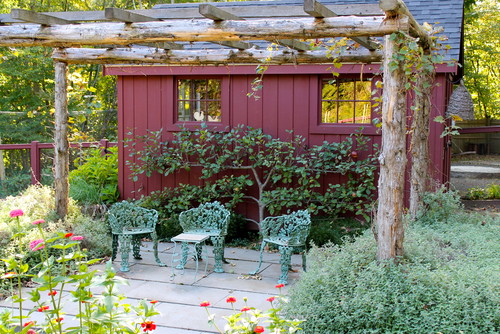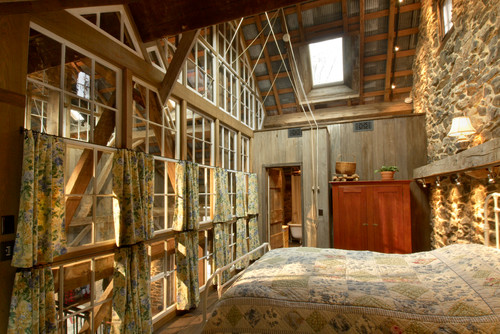From Summer Kitchens to Milking Parlors: A Guide to the Most Charming Outbuildings

SHED Architecture & Design via Houzz
There’s the main house, garage, a barn—and you can probably identify a silo. But what if you spy another building that looks kind of old and weathered? Maybe a wooden shack, way out in a field?
In fact, some homes come with several sheds or buildings. But as for their various uses? Well, that might leave you scratching your head.
Having a rustic structure on a large parcel of land can add charm and even value, if the building is still usable.
Amy Rosen, of Ruth Gale Realty in Phoenicia, NY, reports no shortage of these buildings on upstate New York properties; and she says they’re quite desirable.
“Shed-type buildings have long been needed to store garden supplies and firewood,” she explains. “And the size of the property needn’t be sprawling to accommodate them.”
But if your lot is on the small side, learn the zoning code requirements in your area before you begin to build or improve upon a structure you own, she adds.
For some help telling these outbuildings apart—and some ideas for making them useful—read on.
Summer kitchen
 Photo by Christine Darnell Gardens
Photo by Christine Darnell Gardens
In the 18th and 19th centuries, making dinner was a dreadfully hot task—thanks to all that cooking over open fires and on wood or coal stoves. So when summer rolled around (and if your family had the means), this smoky chore shifted to the summer kitchen— a small structure often separated from the main house.
Summer kitchens were made of brick, stone, or wood and were compromised of a stove and some workspace for food prep.
Today’s modern homeowner, of course, is far likelier to grill and chill on the patio when June rolls around. While a summer kitchen is still an interesting feature on a rural property, it could certainly be converted into storage spot.
“Few homeowners are looking to reduce the amount of storage they have, so outbuildings can be excellent places to put additional vehicles, lawn furniture, and other equipment,” shares Pamela O’Brien, interior decorator at Pamela Hope Designs.
Potting shed
Back in the day, a large- or even medium-sized estate usually employed a gardener to keep the lawns and flowers looking their best. As such, these homes usually had potting sheds—outbuildings designed to hold pots, seeds, soil, and various implements.
“Serious gardeners with this structure on their property would do well to add a windowed roof to it, so it might double as a greenhouse,” notes Tony Mariotti, a real estate broker and owner of RubyHome in Los Angeles.
With glass overhead, you can get a jump-start on sowing spring seeds and keep tomato plants, he adds.
Or you can always turn it into a writing retreat or she shed.
Milking parlor
At one time in America, cows were a part of the family. They lived right next door in the barn, and next to that was the milking parlor.
A milking parlor, also called a milk house, was a one-room outbuilding used to store fresh milk in a cool, clean spot. This was, of course, before modern refrigeration. The milking parlor would also have served as a workspace for making cheese and butter.
Got a milk house as part of your backyard? O’Brien notes these structures might now be better used as bonus rooms—think studio, home office, or playhouse for the kids.
“In the wake of the pandemic, we’ve seen a massive explosion of work-from-home needs in our area,” Rosen says. “So home offices are being adapted from prefab sheds and small barns, merely by adding electric and heat.”
Ice mound
Also called an ice pit or ice house, this outbuilding was once essential for keeping food cold. Typically built from stone and insulated with straw, an ice house may have a rounded top and could be partially built into the ground. Other similar, single-use structures include washhouses for laundry, and sheds for chickens and hogs.
Old structures like these are ideal for off-season storage (think container pots, gardening gear, and other tools).
“In a post-COVID world, the more amenities, the better—and repurposing outbuildings can add great value,” says Damian Hall, a real estate agent with the Damian Hall Group in Greenville, CA.
Tobacco barn
 Photo by Lancaster County Timber Frames, Inc.
Photo by Lancaster County Timber Frames, Inc.
Once ubiquitous on large farms and properties in America, tobacco barns are now largely considered antiques.
Used to air-cure tobacco leaves, these unpainted outbuildings were both square and rectangular and were taller than they were wide. Tobacco barns made from sawn logs and stone were once seen all over the south, with many in North Carolina.
Today, timbers and wood from repurposed tobacco barns can create a weathered-yet-cozy living space, like the one shown above.
The post From Summer Kitchens to Milking Parlors: A Guide to the Most Charming Outbuildings appeared first on Real Estate News & Insights | realtor.com®.


